
Benchmarking capital targets for Private Health Insurance
APRA’s new capital framework for Private Health Insurance is in effect from 1 July 2023.
The new standards aim to strengthen risk sensitivity, improve comparability across insurers (more prescriptive) and align with APRA’s capital framework for life and general insurers (LAGIC), which is consistent with international best practice.
As APRA has strengthened the capital framework for Private Health Insurance (PHI), the minimum capital requirements for the industry are expected to increase.
A new capital framework provides an opportunity for PHI to review their approach to capital management and setting capital targets.
The purpose of this article is to explore the questions that arise, including:
- How do PHIs compare in respect of capital under the previous standard?
- How does Private Health Insurance compare to General Insurance in terms of the ratio over the minimum prudential capital amount (PCA), given how the standards are now aligned?
This benchmarking does not suggest an appropriate level of capital for any individual PHI.
Key terms
Throughout this article, we use some key terms and abbreviations including:
|
Terms |
Details |
|
Prudential Capital Amount (PCA) |
The sum of APRA’s prescribed Insurance Risk Charge, Asset Risk Charge, Asset Concentration Risk Charge and Operational Risk Charge, less adjustments for aggregation and tax (if applicable) |
|
Prudential Capital Requirement (PCR) |
The sum of the PCA and any supervisory adjustment determined by APRA. When there is no supervisory adjustment, the PCA and PCR are equal. This is the absolute minimum amount of regulatory capital a private health insurer is required to hold, although in practice insurers must hold buffers over this level. |
|
Tangible capital or Eligible capital |
Net assets adjusted to remove intangibles and other specified assets |
|
Deferred Claims Liability (DCL) |
Liabilities provision for “missing claims” during the pandemic which is expected to return as “deferred claims” |
|
Capital Adequacy Multiple (CAM) |
The ratio of the eligible capital to the prescribed capital requirement |
PHI capital levels by insurer
Let’s define an insurer’s capital as its net assets; that is, assets minus liabilities. The chart below ranks insurers’ capital strength (as a percentage of FY22 premiums) at 30 June 2022.
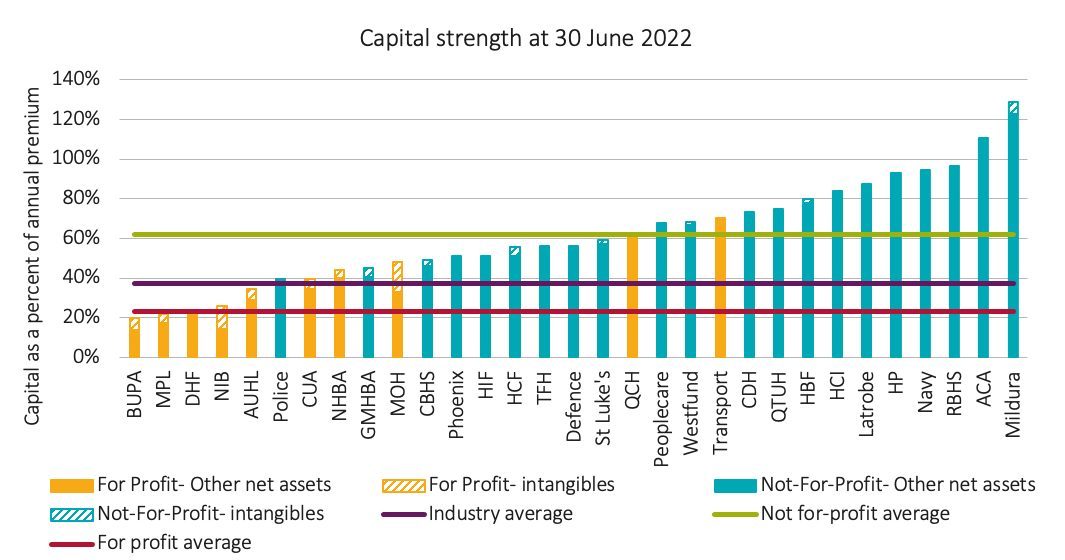
Source: APRA Operations of Health Fund and Finity analysis (as included in Finity PHI Cheat Sheet 2022)
The industry average capital as a percentage of premium at 30 June 2022 was 37%. Under the new capital framework, APRA has realigned its approach to capital quality for PHI, allowing specified assets to form the capital base.
For comparison, we have removed intangibles and deferred acquisition costs to illustrate the capital base (tangible capital) going forward. The industry average tangible capital was 32% as a percentage of premium at 30 June 2022 (FY21: 33%). Those insurers with capital below the industry average generally have access to capital markets or access to additional capital support due to its company structure.
Insurer capital by profitability and size
Another way to consider an insurer’s capital strength is to compare capital by profitability margin and size. The chart below shows tangible capital against the average five-year net margin, with the bubble size reflecting Fund premium in FY22.
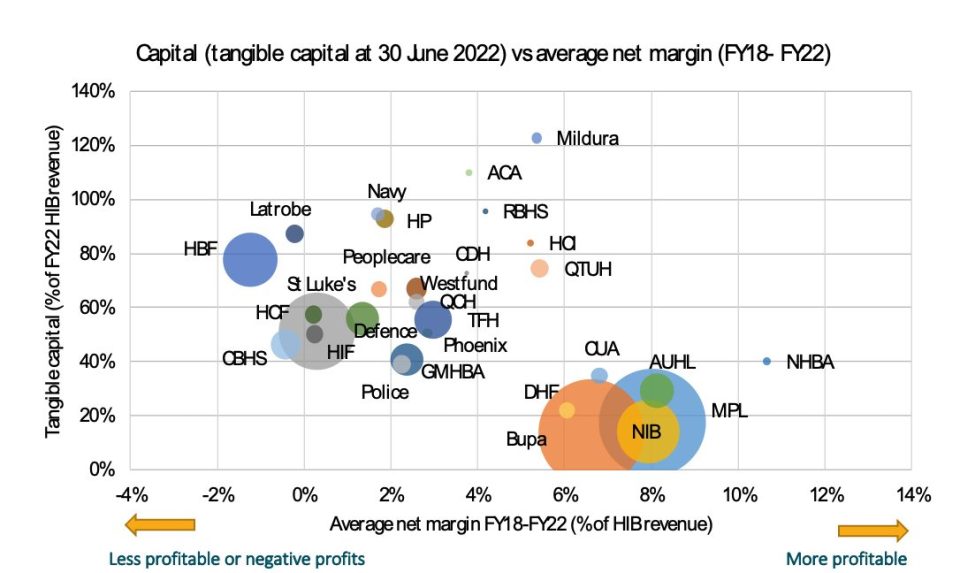
Source: APRA Operations of Health Fund and Finity analysis (as included in Finity PHI Cheat Sheet 2022)
Capital and profitability margins are measures of an insurer’s ability to absorb losses. Available capital is measured as a percentage of annual premium. Underwriting profitability indicates the ability to build capital through net retained earnings. That is partly why we see more profitable funds holding less tangible capital, with the other reason being the company’s structure (for-profit/not-for-profit and having access to additional capital via parent company or investors).
Generally, as an insurer becomes more profitable (high average net margin), the lower the amount of tangible capital held by the fund. Given that profit margin generates future net assets, it enables insurers to consider holding lower capital at the starting point.
Investments and other business can also generate earnings. The strategic asset allocation may also be a consideration in risk appetite and capital targets and triggers.
Asset distribution and allocation to growth assets (equities and properties)
The chart below ranks the funds with the highest proportion of assets in equities and properties at 30 June 2022. This is outside the benchmarking but may be a consideration in where funds sit on capital level benchmarking.
The general assumption may be that to invest more in growth assets, more capital is required. The reality (which is not depicted in this graph) is more complex and depends on risk appetite and more detailed strategic asset analysis. The chart below shows the proportion of assets in equities and property as a consideration when interpreting capital benchmarking.
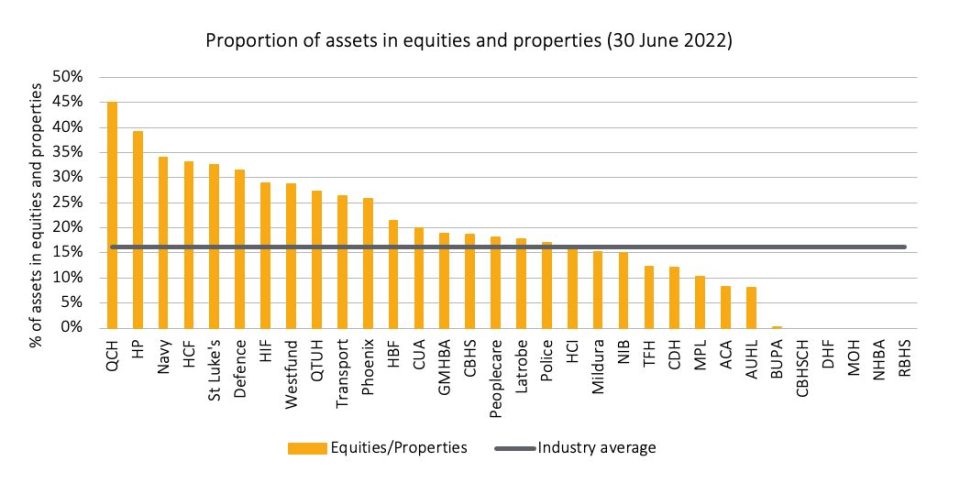
Source: APRA Operations of Health Fund and Finity analysis
The industry average proportion of total assets in equities and properties at 30 June 2022 was 16%. This can be a different percentage if using investable assets. For this graph, we illustrate the range of approaches.
As APRA’s new prudential capital standard applies prescribed risk charges based on asset types, insurers with higher allocations to growth assets will receive a higher capital risk charge and, subsequently, higher PCA. That is, funds that want to hold a higher strategic asset allocation to growth assets (for higher long-term returns) are likely to need higher levels of capital.
PHI capital under the new capital framework
APRA’s Quantitative Impact Study results showed that the industry’s Prudential Capital Amount (PCA) increased from $2.4bn to $3.5bn (14.5% of premium) under the final standard, at 30 June 2021, excluding deferred claims liabilities (DCL). With an industry capital base of $8.6bn (30 June 2021), the implied industry Capital Adequacy Multiple (CAM) would be 2.46, where ‘CAM’ is the ratio of eligible base to PCA.
Benchmarking PHI to General Insurance (GI)
While the PCA itself would allow for different risks by class of business, we can compare the capital buffer over the PCA; that is, comparing PHI’s CAM to that in GI. The following chart compares the GI Industry CAM over the years, and by some of the large listed GI companies.
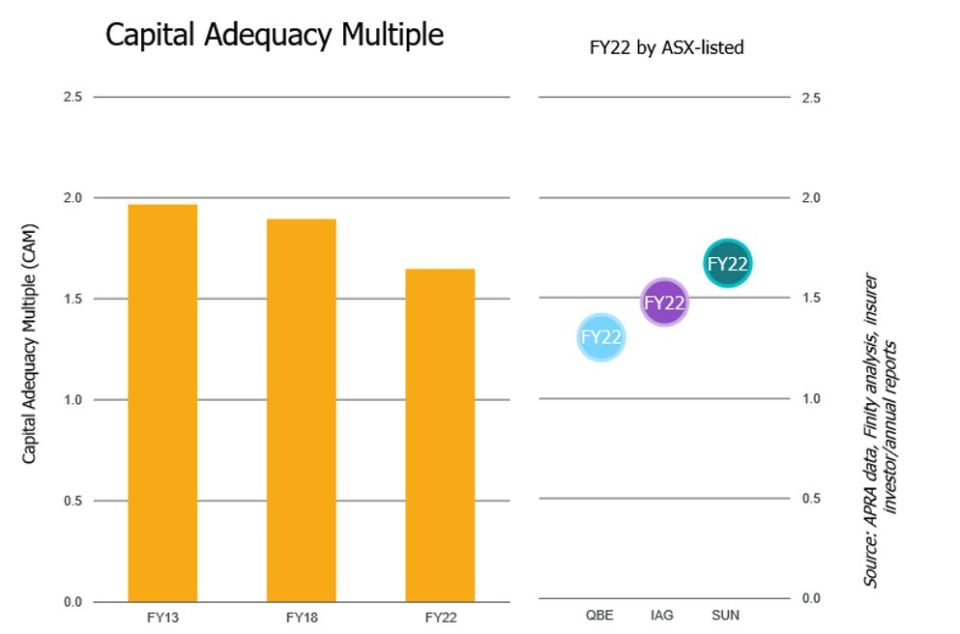
Source: Finity Optima 2022 – https://finity.com.au/news-and-insights/optima22
The GI industry capital adequacy multiple (CAM) at 30 June 2022 was at a level of 1.65. This was down from a level just under 2.0 at 30 June 2017. The Finity Optima Report indicates some GI profitability challenges and events of the last few years, causing a reduction. While it may be a refining of risk appetite, the reduction in capital is likely to be due to experience. This historical trend indicates the industry CAM appears to be between 1.65 to 2.00.
The large listed GI companies (QBE, IAG, Suncorp) typically have lower CAMs of around 1.5x, as shown above. This reflects their larger size, highly diversified portfolio and access to capital markets. If we remove these three larger insurers, the average GI industry CAM is of the order of 1.8x.
Market Announcements for nib and Medibank
Both nib and Medibank announced capital frameworks for the new capital standards in February 2023:
- nib health funds capital management policy indicates a target range of 1.5x to 1.6x PCA. The position at 31 December 2022 was reported at 2.0x and noted as exceeding the target range.
- Medibank has an implied target range of 1.7x to 2.0x PCA. This is based on its capital target of 10%-12% of forecast revenue and its regulatory minimum capital requirement or PCA of 6% of forecast revenue at 31 December 2022.
Conclusion
The intensity of APRA’s supervisory attention will increase as the capital level approaches the PCR. The PCR is the regulatory minimum, and any breach of the PCR can be expected to generate immediate supervisory action. While APRA does not publish prescribed trigger points for regulatory intervention, the general prudential approach is indicated in prudential guidance, such as CPG110.
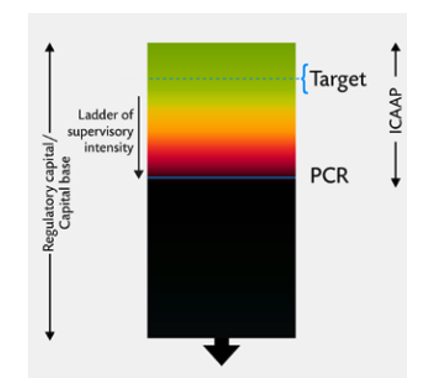
Whist the PCA can be expected to be lower in PHI than for GI (at least based on the quantitative impact study, which had the PCA for PHI at around 14.5% of annual premium), the level of intensity in supervision across industries can also vary.
We set out in this paper to explore how PHIs compare on capital. By scaling for size, these can be compared in APRA statistics for actual capital as a percentage of premium. Actual target capital levels will include a range of considerations: size, profitability, asset mix and risk appetite.
We also explored PHI comparisons to General Insurance in terms of ratio over the minimum prudential capital amount (PCA). The level of cover over the minimum prudential capital amount may be a useful indicator to benchmark across different industries.
Benchmarks are not intended to define capital management practices but as a possible consideration in exploring capital targets and triggers. However, it is useful for Board and management to compare capital levels to that of peers.
CPD: Actuaries Institute Members can claim two CPD points for every hour of reading articles on Actuaries Digital.






